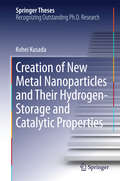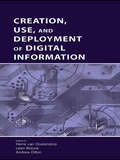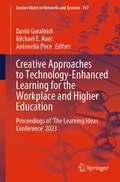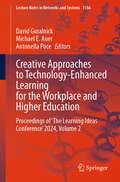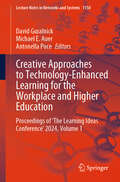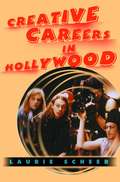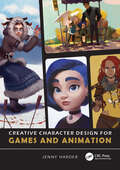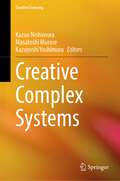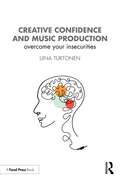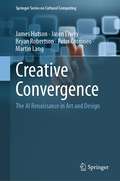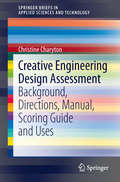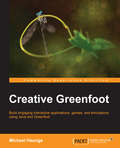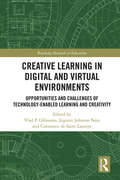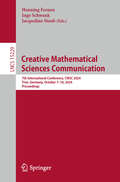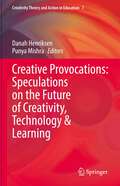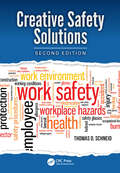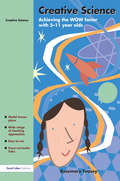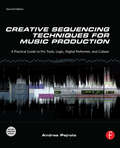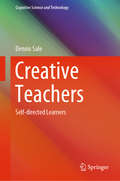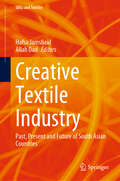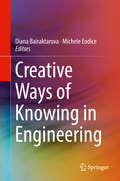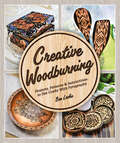- Table View
- List View
Creation of New Metal Nanoparticles and Their Hydrogen-Storage and Catalytic Properties (Springer Theses)
by Kohei KusadaThis thesis reports the discovery of metal nanoparticles having new structures that do not exist in bulk state and that exhibit hydrogen storage ability or CO oxidation activity. Research into the reaction of hydrogen with metals has attracted much attention because of potential applications as effective hydrogen storage materials, as permeable films, or as catalysts for hydrogenation. Also, CO oxidation catalysts have been extensively developed because of their importance to CO removal from car exhaust or fuel-cell systems. At the same time, atomic-level (solid solution) alloying has the advantage of being able to continuously control chemical and physical properties of elements by changing compositions and/or combinations of constituent elements. This thesis provides a novel strategy for the basis of inter-elemental fusion to create highly efficient functional materials for energy and material conversions.
Creation, Use, and Deployment of Digital Information
by Herre Van Oostendorp Leen Breure Andrew DillonThe aim of this book is to present results of scientific research on how digital information should be designed and how artifacts or systems containing digital content should maximize usability, and to explain how context can influence the nature and effectiveness of digital communication. Using a philosophical, cognitive, and technical standpoint, the book covers the issue of what digital information actually is. The text also presents research outcomes from the perspective of research in information science--broadly construed--a term now used to cover a range of theoretical and practical approaches.Creation, Use, and Deployment of Digital Information is broken down into three parts:*Part I presents information on how electronic documents can be realized--the complexities, alternatives, functions, and restrictions are treated here.*Part II discusses how human beings process information and how technical solutions can satisfy human restrictions.*Part III treats the context in which digital information processing and deployment takes place.The book has much to offer to academics in many disciplines, including science, the arts, psychology, education, and the information and computing sciences.
Creative Approaches to Technology-Enhanced Learning for the Workplace and Higher Education: Proceedings of ‘The Learning Ideas Conference’ 2023 (Lecture Notes in Networks and Systems #767)
by Antonella Poce Michael E. Auer David GuralnickNew technologies provide us with new opportunities to create new learning experiences, leveraging research from a variety of disciplines along with imagination and creativity. The Learning Ideas Conference was created to bring researchers, practitioners, and others together to discuss, innovate, and create.The Learning Ideas Conference 2023 was the 16th annual conference and was held as a hybrid event. The conference took place from June 14–16, 2023., both in New York and online, and included a special track: The ALICE (Adaptive Learning via Interactive, Collaborative and Emotional Approaches) Special Track.Topics covered in this book include among others: online learning methodologies, diversity and inclusion in learning, case studies in university and corporate settings, new technologies in learning (such as virtual reality, augmented reality, holograms, and artificial intelligence), adaptive learning, and project-based learning.The papers included in this book are of interest to researchers in pedagogy and learning theory, university faculty members and administrators, learning and development specialists, user experience designers, and others.
Creative Approaches to Technology-Enhanced Learning for the Workplace and Higher Education: Proceedings of ‘The Learning Ideas Conference’ 2024, Volume 2 (Lecture Notes in Networks and Systems #1166)
by Antonella Poce Michael E. Auer David GuralnickNew technologies provide us with new opportunities to create new learning experiences, leveraging research from a variety of disciplines along with imagination and creativity. The Learning Ideas Conference was created to bring researchers, practitioners, and others together to discuss, innovate, and create. The Learning Ideas Conference 2024 was the 17th annual conference and was held as a hybrid event. The conference took place from June 12th-14th, 2024, both in New York and online, and included the ALICE (Adaptive Learning via Interactive, Collaborative and Emotional Approaches) Special Track, and a Special Session from IGIP, the International Society for Engineering Pedagogy. Topics covered in this book include, among others: uses of artificial intelligence in learning, online learning methodologies, case studies in university and corporate settings, new technologies in learning (such as, along with AI, virtual reality, augmented reality, holograms, and more), adaptive learning, and project-based learning. The papers included in this book may be of interest to researchers in pedagogy and learning theory, university faculty members and administrators, learning and development specialists, user experience designers, and others.
Creative Approaches to Technology-Enhanced Learning for the Workplace and Higher Education: Proceedings of ‘The Learning Ideas Conference’ 2024. Volume 1 (Lecture Notes in Networks and Systems #1150)
by Antonella Poce Michael E. Auer David GuralnickNew technologies provide us with new opportunities to create new learning experiences, leveraging research from a variety of disciplines along with imagination and creativity. The Learning Ideas Conference was created to bring researchers, practitioners, and others together to discuss, innovate, and create. The Learning Ideas Conference 2024 was the 17th annual conference and was held as a hybrid event. The conference took place from June 12th–14th, 2024, both in New York and online, and included the ALICE (Adaptive Learning via Interactive, Collaborative and Emotional Approaches) Special Track, and a Special Session from IGIP, the International Society for Engineering Pedagogy. Topics covered in this book include, among others: uses of artificial intelligence in learning, online learning methodologies, case studies in university and corporate settings, new technologies in learning (such as, along with AI, virtual reality, augmented reality, holograms, and more), adaptive learning, and project-based learning. The papers included in this book may be of interest to researchers in pedagogy and learning theory, university faculty members and administrators, learning and development specialists, user experience designers, and others.
Creative Careers in Hollywood
by Laurie ScheerReaders will discover real-life, yet upbeat portraits of the "shredder" jobs of the industry, such as assistant or d-girl, and how they can lead to the "keeper" jobs of actor, agent, or studio executive. Each career overview features a clever analysis of the classic film characters who memorably played these jobs on screen; an insightful rewards-risks assessment of the job; and a brief look at such essential job qualities as durability, length of stay, "food chain value" and desirability factor. Part how-to guide, part historical document, and part social commentary, this book will delight career seekers, Hollywood insiders, and film aficionados alike!
Creative Character Design for Games and Animation
by Jenny HarderThis book takes you through all the basic steps of character design for games and animation, from brainstorming and references to the development phase and final render. It covers a range of styles such as cartoon, stylized and semi-realistic, and explains how to differentiate between them and use them effectively. Using a step-by-step approach for each stage of the process, this book guides you through the process of creating a new character from scratch. It contains a wealth of design tips and tricks as well as checklists and worksheets for you to use in your own projects. This book covers how to work with briefs, as well as providing advice and practical strategies for working with clients and creating art as a product that can be tailored and sold. This book will be a valuable resource for all junior artists, hobby artists, and art students looking to develop and improve their character development skills for games and animation.
Creative Complex Systems (Creative Economy)
by Kazuo Nishimura Masatoshi Murase Kazuyoshi YoshimuraIn recent years, problems such as environmental and economic crises and pandemics caused by new viruses have been occurring on a global scale. Globalization brings about benefits, but it can increase the potential risks of “systemic problems”, leading to system-wide disruptions. The coronavirus pandemic, declared on March 11, 2020, by the World Health Organization, has revealed social disparities in the form of a higher risk of death for people of low-socioeconomic status and has caused massive destruction of the economy and of globalization itself. Extensive efforts to cope with these challenges have often led to the emergence of additional problems due to the chain of hidden causation. What can be done to protect against such emerging challenges? Despite the resulting complexity, once these individual problems are considered as different aspects of a single whole, seemingly contradictory issues can become totally understandable, as they can be integrated into a single coherent framework. This is the integrationist approach in contrast to the reductionist approach. Situations of this kind are truly relevant to understanding the question, “What are creative complex systems?” This book features contributions by members and colleagues of the Kyoto University International Research Unit of Integrated Complex System Science. It broadens our outlook from the traditional view of stability, in which global situations are eventually stabilized after the impact of destruction, to “creative” complex systems.
Creative Confidence and Music Production: Overcome Your Insecurities
by Liina TurtonenCreative Confidence and Music Production: Overcome Your Insecurities is a practical guide for music producers to tackle self-doubt and navigate the relationship between confidence and creativity, by offering tools to overcome the most common creative blocks.The book begins by discussing the interrelationships between confidence, creativity, and working with technology. This is followed by chapters featuring expert tips and practical exercises to help readers overcome challenges such as struggling with confidence in their production process, and navigating the music industry as an artist. Also included are sections that focus on creative music production workflows, providing practical tips on how to find creative direction and how to work through creative blocks, before finishing with real stories from a range of diverse music professionals about their own workflows, what inspires them, and how they overcome doubt, uncertainty, and lack of inspiration.Although mainly aimed at music producers, Creative Confidence and Music Production has plenty of insights for anyone in the music industry, and can help beginners, music production students, and seasoned professionals alike, to face their fears and foster confidence in their practice.
Creative Convergence: The AI Renaissance in Art and Design (Springer Series on Cultural Computing)
by James Hutson Jason Lively Bryan Robertson Peter Cotroneo Martin LangEmbark on a journey that transcends the boundaries of art and technology in the groundbreaking realm of Creative Convergence: The AI Renaissance in Art and Design. This isn't just another book on art and technology- it's a journey that sparks curiosity, fuels innovation, and challenges traditional artistic boundaries. Discover the power of generative Artificial Intelligence (AI) as it melds with human expression, propelling artistry into uncharted territories and redefining traditional notions of both originality and creativity. The text is not just about art or AI; it is about the fusion of both, catalyzing a creative revolution that challenges previous assumptions about human-machine collaboration and how ideation, conceptualization, process and execution are radically rethought. Have you ever wondered how/will AI revolutionize training, education and execution in art and design? Delve into this captivating treatment that contextualizes the disruptions we are experiencing today in the technological innovations and artistic responses and integrations of the past five hundred years. Human creativity has always struggled against technological advance, but ultimately integrated and redefined what "art" is in each era. As such, you will see how AI can be incorporated in various artistic disciplines in this study. Explore real-world case studies that showcase AI's practical impact on 3D design, drawing, digital art, and even web design. The book also addresses the controversial question: Can AI be a co-creator in the creative and artistic process, even assisting in creating an original, signature style? Brace yourself for revelations that will challenge your perceptions of traditional artistry.
Creative Engineering Design Assessment: Background, Directions, Manual, Scoring Guide and Uses (SpringerBriefs in Applied Sciences and Technology)
by Christine CharytonThe Creative Engineering Design Assessment or CEDA is a newly developed tool to assess creativity specific to engineering design which is vital for innovation. The revised CEDA assesses usefulness in addition to originality. Both originality and usefulness are key constructs in creativity but are primarily essential and emphasized ever more in engineering design. Since the preliminary research was presented to the National Science Foundation, further reliability and validity has been developed and established. The CEDA is different from other general creativity measures as it demonstrates discriminant validity with the Creative Personality Scale, Creative Temperament Scale, and the Cognitive Risk Tolerance Scale, and has demonstrated convergent validity with the Purdue Creativity Test and the Purdue Spatial Visualization Test- Rotations. It focuses on engineering specific measures, measuring engineering creativity and spatial skills. The aim of this book is to disseminate the CEDA tool for use in engineering educational programs, industry, NASA and the military. Creative Engineering Design Assessment (CEDA) Background, Directions, Manual, Scoring Guide and Uses discusses and outlines the need for creativity in our global economy and in engineering design and provides the CEDA tool in effort to achieve this.
Creative Greenfoot
by Michael HaungsThis book is for coding students and Java programmers of all levels interested in building engaging, interactive applications with Greenfoot. Familiarity with the very basics of Greenfoot is assumed.
Creative ICT
by Antony Smith Simon WillcocksFirst Published in 2005. Promoting pupils' creativity in using ICT, this book also encourages learning across core and foundation subjects. The text includes: flexible activities for pupils to work through on their own, in small groups or at home; time-saving screen shots for pupils to refer to as they work through the activities; helpful examples of work so that pupils know what to aim for; additional support sheets that can be used by the pupil or the teacher; departure points for integrated studies; and extension activities that will encourage further creativity. For primary and secondary teachers and ICT- co-ordinators.
Creative Learning in Digital and Virtual Environments: Opportunities and Challenges of Technology-Enabled Learning and Creativity (Routledge Research in Education)
by Vlad P. Glăveanu; Ingunn Johanne Ness; Constance de Saint LaurentOriginally published as a special issue of the Creativity Research Journal, this volume gives a balanced and reflective account of the challenges and opportunities of technology-enabled creative learning in contemporary societies. Providing a current and updated account of the challenges posed by the Coronavirus to online education, chapters more broadly offer conceptual reflections and empirically informed insights into the impact of technology on individual and collective creativity and learning. These thoughts are explored in relation to school achievement, the development of digital educational resources, online collaboration, and virtual working. Further, the book also considers how the creative use of technology poses risks to learning through the accidental or deliberate dissemination of misinformation, and online manipulation of common societal values in the era of COVID-19. Creative Learning in Digital and Virtual Environments looks at the connection between creativity, learning, and school achievement, and analyses the impact of virtual environments on creative expression. It will appeal to postgraduate students in the fields of creativity and learning, as well as to students and academics involved with broader research in areas such as the role of technology in education, e-Learning and distance education. Vlad P. Glăveanu is Associate Professor and Head of the Department of Psychology and Counselling at Webster University Geneva, Switzerland, as well as Associate Professor II at the University of Bergen, Norway. Ingunn Johanne Ness is a Senior Researcher at the Centre for the Science of Learning & Technology, University of Bergen, Norway. Constance de Saint Laurent is a Postdoctoral Researcher at the University of Bologna, Italy.
Creative Mathematical Sciences Communication: 7th International Conference, CMSC 2024, Trier, Germany, October 7–10, 2024, Proceedings (Lecture Notes in Computer Science #15229)
by Henning Fernau Inge Schwank Jacqueline StaubThis book constitutes the refereed proceedings of the 7th International Conference on Computer Science and Mathematics , CMSC 2024, held in Trier, Germany, during October 7–10, 2024. The 17 full and short papers included in this book were carefully reviewed and selected from 26 submissions. They were organized in topical sections as follows: Invited Papers; Tactile Learning: Unplugged Graphs, Trees, and Patterns; Teaching Advanced Concepts Using Tangible Machines; Curricular Desicion-Making; Computational Thinking and Interdisciplinary Instruction; Innovative Teaching Beyond the Classroom.
Creative Provocations: Speculations on the Future of Creativity, Technology & Learning (Creativity Theory and Action in Education #7)
by Danah Henriksen Punya MishraThis book explores the complex, yet critical, relationship between technology and creativity, specifically in educational contexts. Creativity is important for success in today’s rapidly changing, radically contingent and hyperconnected world. This is even more relevant in the context of teaching and learning—where the psychological, sociological and cultural aspects of human learning confront the challenges of a rapidly changing, technologically saturated world. Written by some of the foremost thinkers and researchers in the area of creativity and/or technology, the chapters in this volume examine the impact of recent and future technologies on creativity, teaching and learning. Individually and collectively, they help us develop an understanding of this nexus of creativity and technology for education. They offer new perspectives on this rapidly evolving future—exploring issues, paradoxes, tensions, and points of interest for creativity and technology. They position these issues in ways that consider implications for thinking, learning, teaching, and education in general.
Creative Safety Solutions (Occupational Safety And Health Guide Ser. #18)
by Thomas D SchneidIn today's rapidly changing workplace, safety and loss prevention professionals cannot always "go by the book" for the answers to new and unique problems and issues. When there is no tried-and-true solution to a problem, safety and loss prevention professionals must think outside of the box of conventional solutions and develop new and creative sol
Creative Science: Achieving the WOW Factor with 5-11 Year Olds
by Rosemary FeaseyThrough a refreshing blend of theory and practice this book provides stimulating material to develop creative approaches to science in the classroom. It includes: a range of teaching approaches that relate directly to the topic under discussion examples of pupils' work that portray how theory can be translated into practice quick off-the-shelf example model lesson plans which can be adapted. User-friendly and clearly laid out this book is a core text for primary teachers, NQTs and students who want to inject some creativity into their teaching and put that "WOW" factor back into their science lessons.
Creative Sequencing Techniques for Music Production: A Practical Guide To Logic, Digital Performer, Cubase And Pro Tools
by Andrea PejroloAn inspirational guide for all levels of expertise, Creative Sequencing Techniques for Music Production shows you how to get the most out of the four leading audio sequencers, Logic, Pro Tools, Digital Performer, and Cubase. Using real-life examples, Andrea Pejrolo demonstrates a wide range of technical and creative techniques, giving you tips and new ideas to help you take your work to the next level. If you are producing music and looking to build your skills in orchestration, composition, and mixing you will find all the techniques and practical advice you need in this book. Featuring essential tools, that are now part of the everyday creative process in a digital production environment, to give you the most recent and cutting edge techniques- including swipe-comping, time-stretching, pitch correction, elastic-time, advanced-freezing, and new software synthesizers. The material on the website contains loops, templates, audio examples, and end of chapter exercises to practice new skills, this illustrated practical guide provides all the tools you will need to give your music the vital edge. Whether you are a student or amateur aspiring to more professional results, or a professional wanting to master new skills, this book will help you to improve and take the quality of your work to the next level. *Covers all key sequencing topics such as recording and editing techniques and automation groove quantization, converters, sounds layering, tap tempo, creative meter, tempo changes, and synchronization *Teaches mixing techniques that takes advantage of plug-in technology, maximizing the use of effects such as reverb, compressor, limiter, equalizer, and much more *A website loaded with more than 90 examples of arrangements and techniques, giving you advice on how to troubleshoot those common mistakes and perfect your music production.
Creative Systems in Structural and Construction Engineering
by Amarjit SinghAn examination of creative systems in structural and construction engineering taken from conference proceedings. Topics covered range from construction methods, safety and quality to seismic response of structural elements and soils and pavement analysis.
Creative Teachers: Self-directed Learners (Cognitive Science and Technology)
by Dennis SaleThis book offers teaching/training professionals an evidence-based pedagogic guide to teaching effectively, efficiently and creatively – also known as Creative Teaching Competence. Firstly it summarizes the extensive research on human psychological functioning relating to learning and how this can be fully utilized in the design and facilitation of quality learning experiences that maximize attainment and engagement opportunities. Secondly, it demonstrates what creativity actually ‘looks like’ in terms of specific teaching practices, modeling the underpinning processes (syntax) of creative learning design. It then establishes Metacognitive Capability as the superordinate twenty-first century competency; in that this unique human attribute can significantly enhance the cognitive and motivational strategies essential for facilitating self-directed learning and wellbeing. The book helps teaching/training professionals to thoughtfully apply evidence-based knowledge and strategies to today’s challenges, such as developing self-directed learners, enhancing intrinsic motivation, utilizing technology for learning and teaching, developing curricula for twenty-first century competencies and optimally framing and developing the heightened teacher expertise required today.
Creative Textile Industry: Past, Present and Future of South Asian Countries (SDGs and Textiles)
by Hafsa Jamshaid Allah DadThis book gives a comprehensive overview of the creative textile industry and its sectors involved in South Asian countries namely Pakistan, India, and Bangladesh. It provides basic knowledge about the textile, fabric manufacturing techniques, processing, and design method used for the development of creative textile products from the three countries in the past till the 1900s to the present 2023 and discusses the future challenges and prospects. It introduces the concept of a multi-species design process as the future need to obtain a sustainable product cycle of creative textile fabrics. The content of this book appeals to academic researchers, industrial practitioners, and policymakers who are interested in the creative textile industry in South Asia, its economics, and sustainability.
Creative Thinking And Problem Solving
by John FabianA practical new book for scientists, engineers, project leaders, and others working in the technical fields. The book adds depth, "how-to", and success to your creative thinking and problem solving.This book will allow you to sharpen your creative edge, giving you better problem solving skills. Whether you are a scientist working on breakthrough research, an engineer on the forefront of product development, or a project manager forging teams to reach and exceed goals, this new book gives you the fundamentals and advanced techniques of creative thinking to break new ground and reach higher levels of excellence.
Creative Ways of Knowing in Engineering
by Michele Eodice Diana BairaktarovaThis book offers a platform for engineering educators who are interested in implementing a "creative ways of knowing" approach to presenting engineering concepts. The case studies in this book reveal how students learn through creative engagement that includes not only design and build activities, but also creative presentations of learning, such as composing songs, writing poems and short stories, painting and drawing, as well as designing animations and comics. Any engineering educator will find common ground with the authors, who are all experienced engineering and liberal arts professors, who have taken the step to include creative activities and outlets for students learning engineering.
Creative Woodburning: Projects, Patterns and Instruction to Get Crafty with Pyrography
by Bee LockeTurn an ordinary piece of wood into a fire-burned masterpiece!If you're a crafter or an artist looking for something new and different, try pyrography. With this type of art, you use a heated instrument to burn images and words into wood. By using techniques from drawing, such as shading and stippling, you can also add depth and embellishments to your creations.It's easy to get started with pyrography–and Creative Woodburning can help you jump into this hot new craft. This book features: • An introduction to pyrography and the tools you need to get started • Expert advice on how to choose the right materials and how to create a safe working environment • 20 projects, including a jewelry box, a cutting board, a wooden egg, a clock, and a gourd birdhouse • More than 180 patterns–from animal and nature designs to borders and geometric and decorative shapes • Techniques for shading, adding color, and sealing your projectsThe power of your pyrography imagination is just between your fingertips and Creative Woodburning can help you tap into your inspiration. Even if you've never done burning of any kind before, pyrography expert Bee Locke can show you a safe yet fun way to play with fire.
